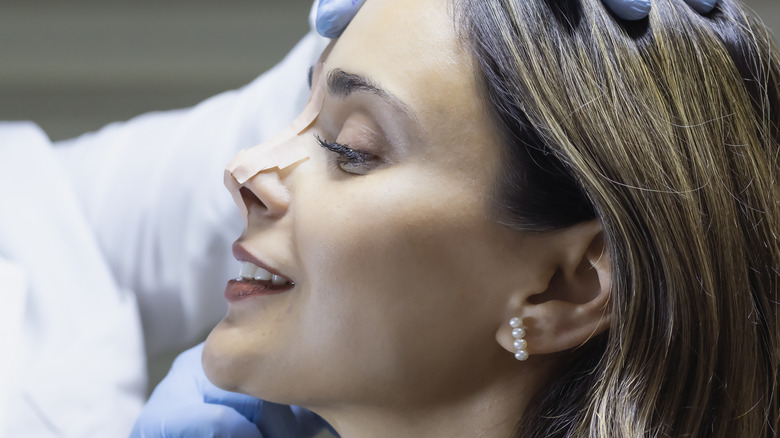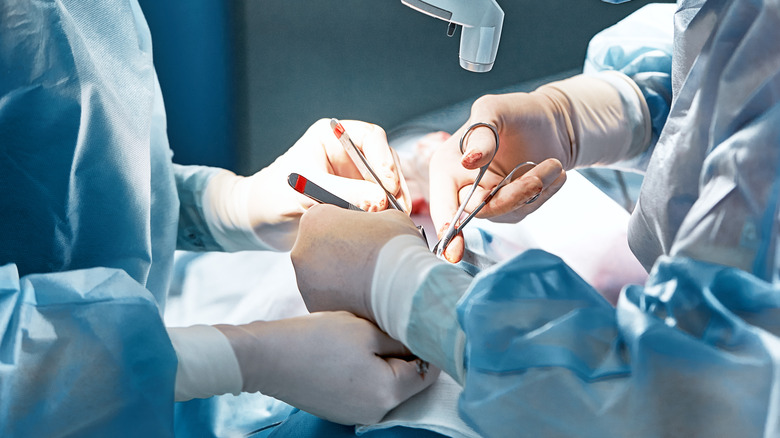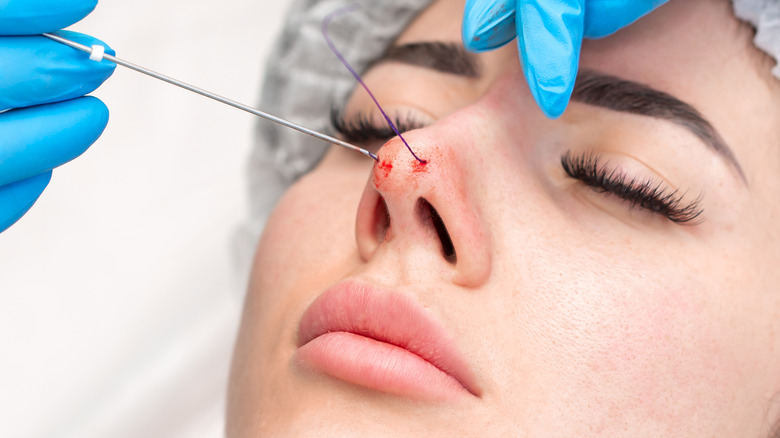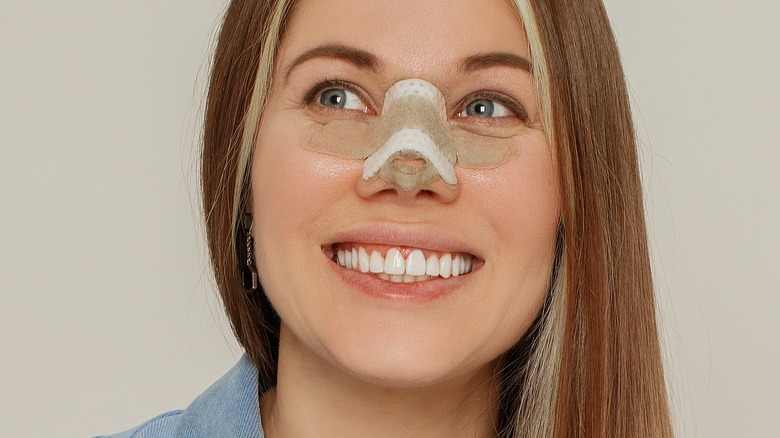What's A Tip-Lift Nose Job & How Is It Different Than A Traditional Rhinoplasty?
A rhinoplasty procedure (aka a nose job) is one of the most popular cosmetic surgeries worldwide, according to the National Library of Medicine. Not only does it alter the size of the nostrils or nose bridge to boost facial harmony, but it can also help with impaired breathing caused by a deviated septum. There's no questioning the positive impact of rhinoplasty on a person's appearance and overall confidence. However, along with technological advancements, the way a nose job is done is also constantly changing. A tip-lift nose job, a more simple version of a full-on rhinoplasty, is one of the most sought-out cosmetic surgeries lately.
A traditional rhinoplasty typically involves a complex surgery with extensive downtime. With a tip-lift nose job, however, people can have their nose reshaped with an easier course of recovery and a lower risk of complications. With this procedure, the nasal tip is lifted to improve the appearance of the nose. As the most prominent part of the nose, the nasal tip is a pyramidal structure that extends away from the face's plane perpendicularly. It is composed of layers of skin, cartilage, muscles, and fibrous structures with very little fat. For some people, a subtle change in the nasal tip alone suffices to alter their whole look.
Facial plastic surgery like a traditional rhinoplasty is a major decision with lasting effects. If you're anxious about giving your nose a major overhaul, put a nose tip lift on your radar. Here's everything you need to know about a tip-lift nose job, including its unique benefits and potential risks.
What is a tip-lift nose job or tip rhinoplasty?
A tip-lift nose job, commonly referred to as tip rhinoplasty, is an operation that focuses on the nasal tip instead of the entire nose, according to VBB Gentek. A tip-lift nose operation does not shatter the nasal bone, unlike a typical rhinoplasty, in order to modify the nose. For example, if you have a droopy or boxy nasal tip, you can enhance your look with just a tip-lift nose job instead of an intensive rhinoplasty. To ensure your nasal tip is in proportion with other parts of the nose, a plastic surgeon might remove excess cartilage from the tip to refine your nose.
A tip-lift nose is most suited for people who see their nose tips as their biggest issues. Perhaps the nostrils are too big for the face, or the tip of their nose is bulbous, droopy, or upturned. The procedure might involve some elevating or contouring of the nose tip or narrowing or widening of the nostrils, depending on the patient's nose anatomy.
Because a tip-lift nose leaves the nose bone untouched, it's a much less invasive and intensive procedure than a traditional rhinoplasty. However, it's still invasive and the results can be long-lasting. If you're looking for a non-invasive option with temporary results, you can opt for a non-surgical tip-lift nose job that allows you to have your nose reshaped with a simple injection.
What is a non-surgical tip-lift nose job?
According to Dermanina, a non-surgical tip-lift nose job is a micro-procedure that involves a hyaluronic acid injection (dermal filler) to the nasal tip cartilage to give it an ever-subtle lift. There are different types of dermal fillers that can be used to carry out a tip-lift nose job. Dermal fillers can be found in temporary, semi-permanent, or permanent forms, with temporary fillers being the most commonly used in non-surgical rhinoplasty. Hyaluronic acid is a naturally occurring slippery substance found in your joints and skin, meaning your body reacts well to it and there should be a lower risk of adverse reactions.
With a non-surgical tip-lift nose job, you can get a clean slate whenever you want. Hyaluronic acid can be easily dissolved with hyaluronidase, a natural enzyme also found in our bodies. If you're not happy with the end result or side effects that occur, you can always reverse them with hyaluronidase to prevent further complications. For this reason, a dermal filler nose tip lift is a great option for those who want to enhance their tip but are not ready to commit to the changes.
What a tip-lift nose job looks like
A surgical tip-lift nose job typically lasts around one to two hours. The patient will come under local anesthesia during the process.
During your tip-lift nose job, your surgeon will make an incision into the small bridge between your nose, as well as your nostrils to open up the tip cartilage and all other tip structures. Your surgeon will reposition the incision in such a way that it stays hidden so you don't have to worry about visible scarring. Then, your surgeon will move on to reshaping the lower cartilage of your nose. Depending on the anatomy of each patient's nose, the plastic surgeon might recommend a single treatment or a combination.
The nostrils can be streamlined for a symmetrical look, or the bulging tip cartilages can be thinned out to appear more projected and refined. If you have a boxy nose tip with a dorsal hump, the surgeon might combine the tip-lifting technique with other rhinoplasty techniques to smooth over the hump. During the surgery, septoplasty may also be performed if there is a septal deviation in the tip region.
Following the completion of all procedures, the surgeon uses dissolvable sutures to close the incision. The incision is also covered with bandages and silicone splints for up to five days. This is an outpatient procedure so you can go home the same day.
Tip-lift recovery and after care
As far as recovery goes, most tip rhinoplasty patients can resume normal activities after one to two weeks following the procedure. However, full recovery might take up to six months or a whole year. Swelling and bruising are common post-op effects and will usually subside after a couple of weeks. Your surgeon will prescribe you medications to help you cope with the swelling and the pain.
When you're healing from a nose job, you're advised to use a nasal spray to freshen up and moisturize the inside of your nose and to apply cold compresses to minimize swelling. To minimize trauma on the nose, you should also refrain from strenuous activities, such as exercising, jogging, or weight lifting for the first three weeks until your doctor says it is okay to do so. You should also avoid direct sunlight and refrain from smoking or vaping as your nose is still healing. When you're sleeping, prop yourself up on the pillows and sleep on your back with your head in an elevated position to avoid hurting your nose and minimize congestion.
Like a rhinoplasty, it might take you anywhere between nine to 12 months to see the final result of your nose job and decide if it really suits you.
Risks of a tip-lift nose job surgery
Since a tip-lift nose job is less extensive than a traditional rhinoplasty, it also poses fewer risks than the former. However, keep in mind that the results of a surgical tip rhinoplasty are permanent and irreversible. Of course, you can always use revision surgery to fix what you don't like, but it's going to be a more complicated process. You should only agree to go under the knife once you're sure that's what you really want.
However, if you are looking to have a non-surgical tip-lift nose job (i.e. dermal fillers), there are some caveats. There have been reports of filler triggering severe complications in the nose's blood vessels, causing infections and even death of the skin tissue (necrosis). "The nose is a high risk site for vascular blockage," Dr. Shereene Idriss, a board-certified dermatologist and cosmetic expert, tells Refinery29. Due to the closed nature of the nose and the presence of end arteries, there are no "backup" vessels there to help with circulation should anything go amiss. Dr. Idriss warns that if the blood flow is disrupted due to injectable fillers, the surrounding tissue lacks a reserve to receive oxygenated blood and, if untreated, decays.
The nose is a tricky body part that entails careful handling. If you want to get a non-surgical nose job using dermal fillers, consult a dermatologist or a plastic surgeon to know all the pros and cons of it before getting one.
Which is better: A full rhinoplasty or a tip-lift?
A complete rhinoplasty can improve both the tip and other areas of the nose, but a tip rhinoplasty concentrates just on the nasal tip. If you have other structural issues that need to be addressed other than the tip, then you likely need a full rhinoplasty. If your aesthetic or medical concerns are concentrated on the tip, then opt for a tip-lift nose job only. A tip-lift nose operation, for example, can address a drooping or upturned nose tip without the need for a complete rhinoplasty. Patients who have already undergone rhinoplasty but are dissatisfied with the results on the tip are more likely to undergo tip reshaping.
Because a tip-lift nose job is a less complicated procedure, it has a quicker recovery period. Swelling may also go down quicker, and you can start seeing the results sooner. In addition, a tip reshaping surgery is often less expensive than a major nose job. Although tip rhinoplasty prices vary from location to location, a tip reshaping procedure normally costs between $5,000 and $10,000. Whether you're opting for a full rhinoplasty or a tip rhinoplasty, make sure you're having your nose operated on by an experienced and qualified surgeon to minimize complications and achieve the most optimal results.






